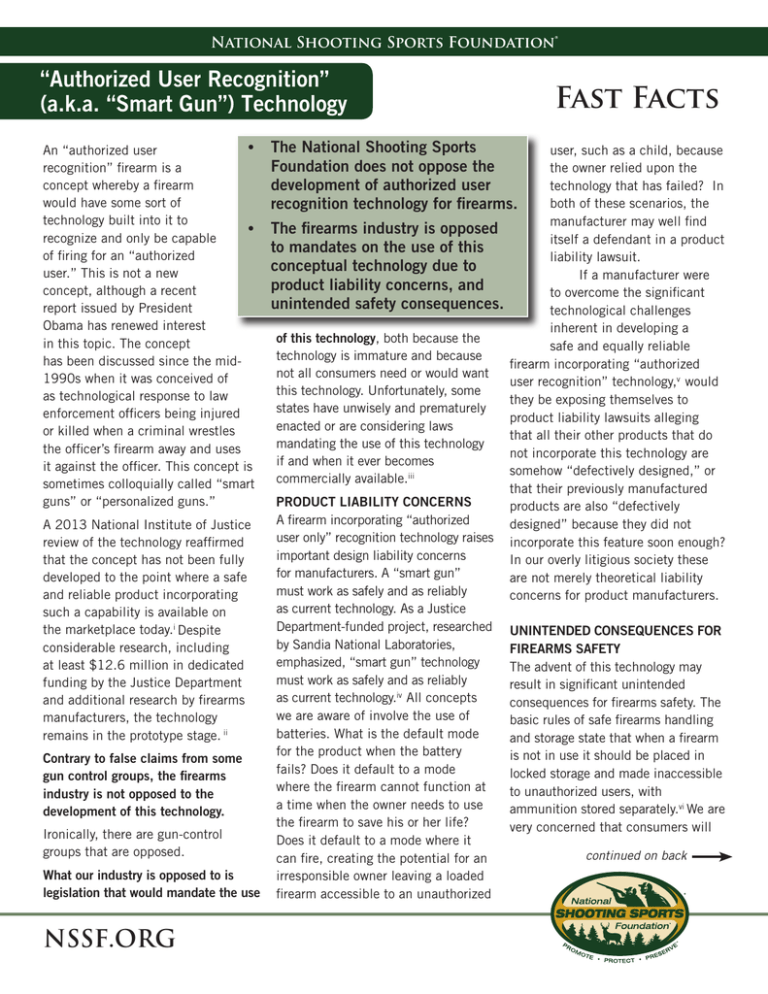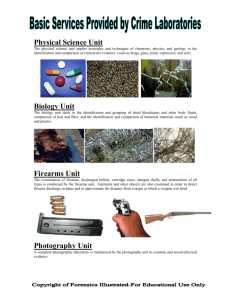
National Shooting Sports Foundation®
“Authorized User Recognition”
(a.k.a. “Smart Gun”) Technology
•
An “authorized user
recognition” firearm is a
concept whereby a firearm
would have some sort of
technology built into it to
•
recognize and only be capable
of firing for an “authorized
user.” This is not a new
concept, although a recent
report issued by President
Obama has renewed interest
in this topic. The concept
has been discussed since the mid1990s when it was conceived of
as technological response to law
enforcement officers being injured
or killed when a criminal wrestles
the officer’s firearm away and uses
it against the officer. This concept is
sometimes colloquially called “smart
guns” or “personalized guns.”
A 2013 National Institute of Justice
review of the technology reaffirmed
that the concept has not been fully
developed to the point where a safe
and reliable product incorporating
such a capability is available on
the marketplace today.i Despite
considerable research, including
at least $12.6 million in dedicated
funding by the Justice Department
and additional research by firearms
manufacturers, the technology
remains in the prototype stage. ii
Contrary to false claims from some
gun control groups, the firearms
industry is not opposed to the
development of this technology.
Ironically, there are gun-control
groups that are opposed.
What our industry is opposed to is
legislation that would mandate the use
NSSF.ORG
Fast Facts
The National Shooting Sports
Foundation does not oppose the
development of authorized user
recognition technology for firearms.
The firearms industry is opposed
to mandates on the use of this
conceptual technology due to
product liability concerns, and
unintended safety consequences.
of this technology, both because the
technology is immature and because
not all consumers need or would want
this technology. Unfortunately, some
states have unwisely and prematurely
enacted or are considering laws
mandating the use of this technology
if and when it ever becomes
commercially available.iii
PRODUCT LIABILITY CONCERNS
A firearm incorporating “authorized
user only” recognition technology raises
important design liability concerns
for manufacturers. A “smart gun”
must work as safely and as reliably
as current technology. As a Justice
Department-funded project, researched
by Sandia National Laboratories,
emphasized, “smart gun” technology
must work as safely and as reliably
as current technology.iv All concepts
we are aware of involve the use of
batteries. What is the default mode
for the product when the battery
fails? Does it default to a mode
where the firearm cannot function at
a time when the owner needs to use
the firearm to save his or her life?
Does it default to a mode where it
can fire, creating the potential for an
irresponsible owner leaving a loaded
firearm accessible to an unauthorized
user, such as a child, because
the owner relied upon the
technology that has failed? In
both of these scenarios, the
manufacturer may well find
itself a defendant in a product
liability lawsuit.
If a manufacturer were
to overcome the significant
technological challenges
inherent in developing a
safe and equally reliable
firearm incorporating “authorized
user recognition” technology,v would
they be exposing themselves to
product liability lawsuits alleging
that all their other products that do
not incorporate this technology are
somehow “defectively designed,” or
that their previously manufactured
products are also “defectively
designed” because they did not
incorporate this feature soon enough?
In our overly litigious society these
are not merely theoretical liability
concerns for product manufacturers.
UNINTENDED CONSEQUENCES FOR
FIREARMS SAFETY
The advent of this technology may
result in significant unintended
consequences for firearms safety. The
basic rules of safe firearms handling
and storage state that when a firearm
is not in use it should be placed in
locked storage and made inaccessible
to unauthorized users, with
ammunition stored separately.vi We are
very concerned that consumers will
continued on back
leave loaded firearms accessible,
relying upon the technology which can
fail. The use of this technology may
create a false sense of security and
encourage unsafe storage practices.
Nothing is more dangerous than
calling a firearm “childproof.”
LACK OF CONSUMER DEMAND
According to a national poll on
authorized user technology, Americans
rate reliability as the most important
factor when deciding whether to
purchase a gun for self-protection or
home defense. However, when asked
about such technology, 74% believe it
would be not be reliable for protection.
For this reason alone, it is logical
that over 80% of Americans would
not be likely to buy a so-called smart
gun and that the technology alone
would not make them more likely to
purchase a firearm with authorized
user technology.
The same poll found nearly two-thirds
of Americans believe it is more safe to
store a firearm in the home unloaded
and secured with a gun lock or stored
in a locked gun safe or cabinet,
compared to storing a firearm loaded
and secured with the latest smart gun
technology. Beyond questions about
reliability and safety, the likely-steep
cost of this technology is another
demand deterrent: half of Americans
Mark Greene, “A Review of Gun Safety Technologies,”
U.S. Department of Justice, National Institute of Justice
Research Report, June 2013.
ii
Mark Greene, “A Review of Gun Safety Technologies,”
U.S. Department of Justice, National Institute of Justice
Research Report, June 2013.
iii
N.J. Stat. Ann. §§ 2C:39-1dd, 2C:58-2a(5)(e), 2C:582.2 – 2C:58-2.5, Md. Code Ann., Pub. Safety § 5-132
iv
D.R. Weiss, “Smart Gun Technology Project Final
Report,” Sandia National Laboratories, SAND96-1131,
May 1996.
v
D.R. Weiss, “Smart Gun Technology Project Final
Report,” Sandia National Laboratories, SAND96-1131,
May 1996.
John. W. Wirsbinski, “’Smart Gun’ Technology Update,”
Sandia National Laboratories, SAND2001-3499,
November 2001.
would not pay a premium for the
technology.
The firearms industry is not opposed
to efforts to develop “authorized user
recognition technology” for firearms.
We support grant funding from the
federal government to support further
research because the technological
hurdles to make an “authorized
user recognition” firearm that is
as safe and as reliable as current
firearms technology have not been
overcome. We are, however, strongly
opposed to “one size fights all”
legislative mandates that have been
proposed and enacted in some states.
Market research by manufacturers
demonstrates there is very little interest
or desire among consumers for a
product with this feature, even were it
available.viii
The vast majority of Americans
nationwide, 70%, are also opposed
to a government mandate that would
require manufacturers to make all
firearms with this technology, if it
were commercially available.
GOOD NEWS ABOUT FIREARM
ACCIDENTS
While there are more firearms owners
and firearms in the United States than
ever before, fatal firearm accidents
have fallen to near record lows since
recordkeeping began in 1903, down
57% in the past 20 years alone.vii This
is a very encouraging trend and has
occurred even without the introduction
to the marketplace of “authorized user
recognition technology.” Every firearm
ever made is capable of being
locked and made inaccessible
Firearms Safety
Depends On You
to unauthorized users through
such means as a gun lock,
like the ones voluntarily
provided by manufacturers
today with every new firearm
shipped from the factory.
The National Shooting Sports
Foundation (NSSF)’s awardwinning Project ChildSafe
program has distributed over 36
million free firearm safety education
kits that include a gun lock and safety
literature throughout the United States.
Firearms Responsibility
In The Home
The Ethica
l Hunter
National Shooting
Sports Foundation®
National
Shooting
Sports Foun
dation®
National Shooting
Sports Foundation®
WWW.NSSF.ORG
WWW.NSSF
.ORG
WWW.NSSF.ORG
i
11 Mile Hill Road
Newtown, CT 06470-2359
T: 203.426.1320
F: 203.426.1087
nssf.org
Don Sebastian, Speech during “Owner Authorized
Handguns, Session 1: Technology for Owner-Authorized
Handguns,” Cited in Workshop Summary, National
Academy of Engineering, 2003.
vi
National Shooting Sports Foundation, “Firearm Safety
-- 10 Rules of Safe Gun Handling,” http://www.nssf.org/
safety/basics/index.cfm?segment=true (Last accessed
March 26, 2013).
vii
The number of unintentional firearms fatalities dropped
from 1,409 in 1992 to 606 in 2010, according to
preliminary data. National Safety Council Injury Facts,
2011 Edition.
viii
Mark Greene, “A Review of Gun Safety Technologies,”
U.S. Department of Justice, National Institute of Justice
Research Report, June 2013.
© 2013 National Shooting Sports Foundation, Inc. All Rights Reserved
PROMOTE
PROTECT
11/13
PRESERVE


